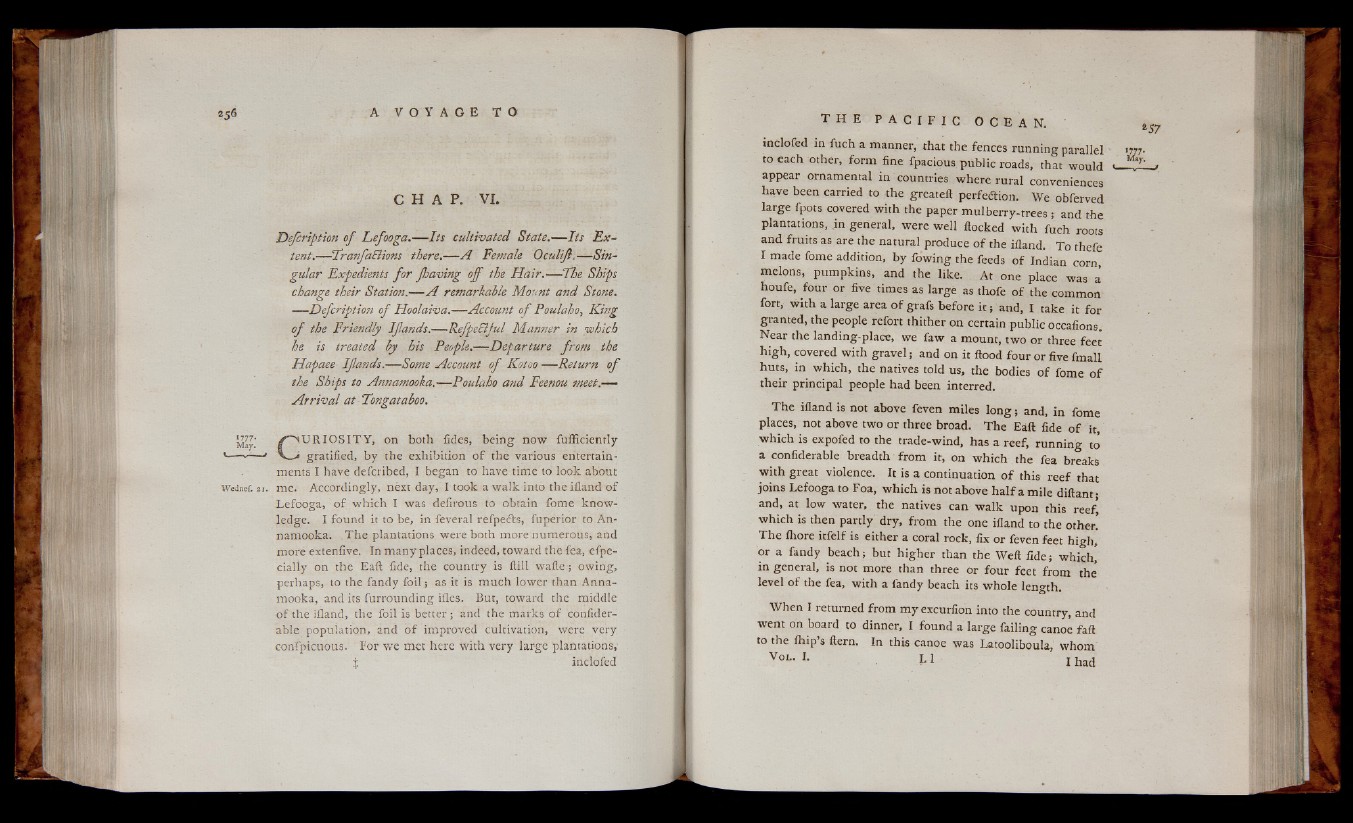
C H A P . VI.
Defcription o f Lefooga.— Its cultivated State.— Its Extent.—
Tranfa&ions there.— A Female Oculiff.— Singular
Expedients fo r Jhaving off the H a ir.— 7he Ships
change their Station.— A remarkable Mount and Stone.
— Defcription of Hoolaiva.— Account o f Poulaho, King
o f the Friendly Ifands.— RefpeEljul Manner in which
he is treated by his People.—-Departure from the
Hapaee Ifands.— Some Account o f Kotoo — Return o f
the Ships to Annamooka,— Poulaho and Feenou meet.—
A r r iv a l at Tongata boo.
^77- /C U R IO S IT Y , on both fides, being now fufficiently
' gratified, by the exhibition of the various entertainments
I have defcribed, I began to have time to look about
WeJncf 2 1 . me. Accordingly, next day, I took a walk into the ifland of
Lefooga, of which I was defirous to obtain fome knowledge.
I found it to be, in feveral refpedts, fupérior to Annamooka.
The plantations were both more numerous, and
moré extenfive. In many places, indeed, toward the fea, efpe-
cially on the Eaft fide, the country is fliil wafle ; owing,
perhaps, to the fandy foil; as it is much lower than Annamooka,
and its furrounding ifles. But, toward the middle
of the ifland, the foil is better; and the marks of confider-
able population, and of improved cultivation, were very
confpicuous. For we met here with very large plantations,'
t inclofed
inclofed in fuch a manner, that the fences running parallel 1777.
to each other, form fine fpacious public roads, that would ■ M.ay~ ■
appear ornamental in countries where rural conveniences
have been carried to the greateft perfection. We obferved
large fpots covered with the paper mulberry-trees ; and the
plantations, .in general, were well flocked with fuch roots
and fruits as are the natural produce o f the ifland. To thefe
I made fome addition, by fowing the feeds of Indian corn,
melons, pumpkins, and the like. At one place was a
lioufe, four or five times as large as thole of the common
fort, with a large area of grafs before i t ; and, I take it for
granted, the people refort thither on certain public occafions.
Near the landing-place, we faw a mount, two or three feet
high, covered with gravel; and on it flood four or five finall
huts, in which, the natives told us, the bodies of fome of
their principal people had been interred.
The ifland is not above feven miles lon g; and, in fome
places, not above two or three broad. The Eaft fide of it,
which is expofed to the trade-wind, has a reef, running to
a confiderable breadth from it, on which the fea breaks
with great violence. It is a continuation of this reef that
joins Lefooga to Foa, which is not above half a mile diftant;
and, at low water, the natives can walk upon this reef’
which is then partly dry, from the one ifland to the other!
The ihore itfelf is either a coral rock, fix or feven feet high,
or a fandy beach; but higher than the Weft fide; which!
in general, is not more than three or four feet from the’
level of the fea, with a fandy beach its whole length.
When I returned from myexcurfion into the country, and
went on board to dinner, I found a large failing canoe fail
to the ihip s ftern. In this canoe was Latooliboula, whom
Vo l - L M I had